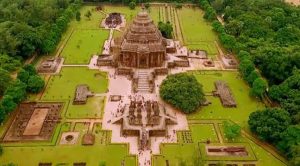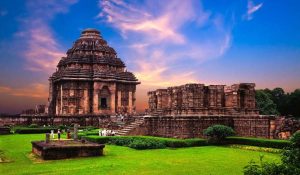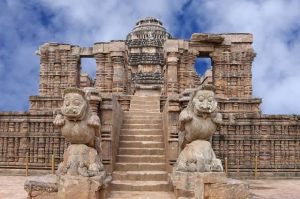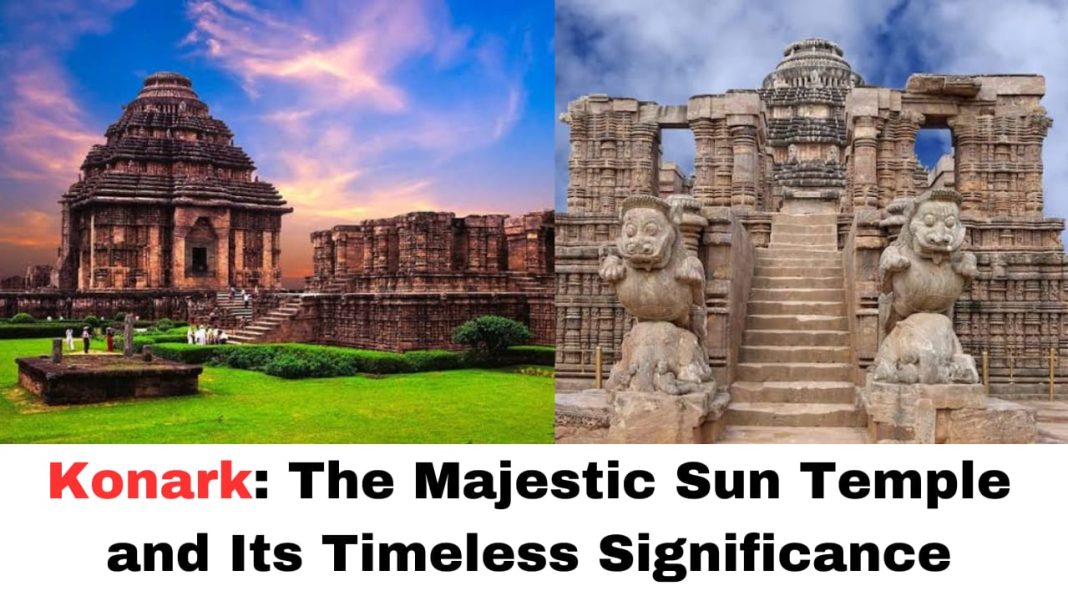Digital News Guru Education Desk:
The Konark Sun Temple
Konark, located on the eastern coast of India in the state of Odisha, is home to one of the country’s most iconic and historically significant monuments — the Konark Sun Temple. Known for its architectural brilliance and intricate carvings, the temple is a UNESCO World Heritage site and an important part of India’s cultural heritage. Konark’s name itself comes from two Sanskrit words: “Kona” meaning corner or angle, and “Arka” meaning sun, symbolizing its dedication to the Sun God, Surya.

Historical and Architectural Significance
The Konark Sun Temple was constructed in the 13th century, under the rule of King Narasimhadeva I of the Eastern Ganga dynasty. It is believed that the temple was completed in 1255 AD, although historical records suggest that the temple took over a decade to complete. The temple’s unique design is inspired by the form of a colossal chariot with twelve pairs of wheels and seven horses, which are depicted in stone. These elements symbolize the chariot of the Sun God, who is believed to travel across the sky in a chariot drawn by seven horses.
The temple’s structure is built entirely of sandstone, which has weathered over centuries. Originally, it was a fully functional and active temple, with the main idol of Surya placed in the sanctum. The temple’s walls and pillars are adorned with exquisite sculptures and carvings, depicting deities, mythological scenes, and daily life in medieval India. These carvings provide a glimpse into the artistic and cultural practices of the time, showcasing the skill of the architects and sculptors of that era.
The temple’s architecture is a fine example of the Kalinga style, which is a blend of intricate stone carvings and grand design. It was once surrounded by a large water tank and lush greenery, enhancing its beauty and prominence. The temple’s alignment with the sun is also remarkable; during the summer solstice, the first rays of the sun fall directly on the temple’s main entrance, illuminating its interiors.
Decline and the Rediscovery of the Temple
The Konark Sun Temple, like many ancient structures, faced decline over centuries due to natural calamities, invasions, and changes in religious practices. By the 16th century, the temple had largely fallen into ruin, with much of the structure and the main idol destroyed. It is believed that the temple was abandoned after the local rulers had to relocate their capital, and with time, the once-vibrant temple complex succumbed to neglect.

The temple was rediscovered in the early 19th century when it was partially unearthed by the British colonial officers. Since then, efforts have been made to restore and preserve the remnants of this architectural marvel, although some parts, including the original idol of Surya, remain lost.
Cultural and Religious Importance
Konark has been a center of religious worship for centuries, primarily devoted to Surya, the Sun God. Pilgrims from across the country once visited to offer prayers and seek blessings for prosperity, health, and spiritual well-being. Even though the original rituals associated with the temple have faded, Konark continues to attract tourists and devotees alike. The Sun Temple is also part of the Char Dham pilgrimage circuit in Odisha, along with Puri, Bhubaneswar, and Jagannath.
The Sun Temple is not just a religious symbol but also a cultural one. The architecture, with its grand carvings, murals, and sculptures, represents the height of Odisha’s artistic achievements. It showcases the Indian belief in the cyclical nature of time and the worship of celestial bodies, which is reflected in the temple’s design. Every year, the Konark Dance Festival is held near the temple, where classical dance performances take place, attracting art lovers and tourists from all over the world.
The Mystery of the Temple’s Construction
One of the enduring mysteries surrounding the Konark Sun Temple is the story behind its construction. Local legends claim that the temple’s construction was guided by a celestial architect, who provided divine knowledge to the artisans. According to one legend, the architect, known as Biswakarma, designed the temple as a way to capture the brilliance of the Sun God in stone. Another myth states that the temple was built using massive magnetic stones, which are said to have caused the collapse of the temple, although this remains a topic of speculation.

Additionally, the role of the magnetic stones is sometimes linked to the story of a large iron beam, known as the “Neelachakra” or blue wheel, which once rested atop the temple’s spire. It is believed that the beam had magnetic properties, which would have created a unique floating effect for the top of the temple. However, this feature has not been conclusively proven, and much about the temple’s original design and functionality remains shrouded in mystery.
Tourism and Modern Day Relevance
Today, Konark continues to be a major tourist destination in Odisha. The Konark Sun Temple not only attracts history and architecture enthusiasts but also people interested in photography, as its unique design makes for stunning visual imagery. The surrounding area is dotted with smaller temples and sacred sites that provide visitors with an immersive experience of both the natural and cultural heritage of the region.
Additionally, the Konark Dance Festival, held annually from December 1 to 5, is a major cultural event that brings together renowned classical dancers from across the country to perform in the shadow of the majestic temple. This festival celebrates India’s rich tradition of dance and music, with performances of Odissi, Bharatnatyam, Kathak, and other classical dance forms.
Konark’s contribution to India’s cultural, religious, and architectural legacy cannot be overstated. It stands as a testament to the ingenuity and artistry of the people of ancient India, and despite the passage of time, it remains a living symbol of the country’s glorious past. The temple is not only a place of worship but also an enduring symbol of India’s rich history, a place where spirituality, art, and science converge.
Conclusion
The Konark Sun Temple remains one of India’s most revered and magnificent monuments, combining religious significance with architectural brilliance. It stands as a powerful reminder of India’s glorious heritage and the incredible craftsmanship of ancient Indian builders. Today, it continues to inspire awe and wonder among visitors and stands as a beacon of India’s cultural heritage, recognized and celebrated worldwide.
You May Also Read: Clashes Erupt at Udaipur City Palace: The Mewar Dynasty Dispute








